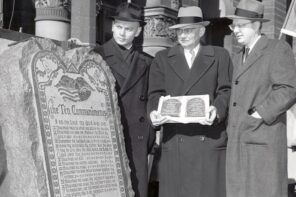June 29th was a bad day for America.
On that day, in front of a courthouse in Bradford County, Florida, American Atheists unveiled a monument to atheism. But it was not a bad day because the atheists were allowed to install their monument on government property, or anywhere else. It was a bad day because the monument is so damn ugly.
The story is that in 2012, Community Men’s Fellowship, a local Christian group, donated a Ten Commandments monument to Bradford County. American Atheists, naturally, saw this as a breach of the separation of church and state. The organization sued, and were granted the right to put up their own monument.
The coverage of the unveiling has largely been focused on the controversy—the Christians are outraged, the atheists delighted. (As far as I can tell, American Jews, Muslims, Hindus, et al, have not weighed in on the matter.)
I’m just as offended as the Christians, but for different reasons. The right to erect a monument, for any cause, is an opportunity. It’s a chance to lend dignity and consequence to a public space. A monument is also an aesthetic opportunity. It doesn’t have to be beautiful, but a successful monument makes it hard to imagine its setting without it.
The American Atheists monument fails on both counts. When granted the opportunity to memorialize atheism in a public place, American Atheists decided to install a bench. In one sense, this is a clever idea, in that it reflects the utilitarian impulse of American atheism. But a bench is also something that you put your butt on.
And this particular bench is an eyesore. About five feet long, the monument looks like, well, a marble bench, but with a four-foot-high pillar at one side.
The pillar displays quotations of a secularist or atheistic bent. Pride of place goes to a long quotation from Madalyn Murray O’Hair, the founder of American Atheists, about atheists preferring hospitals to churches and “a deed” to “a prayer.” On another side is an excerpt from the Treaty of Tripoli, signed by President John Adams: “The United States is in no sense founded on the Christian religion.”
On the back of the pillar is a list of “Punishments for Breaking the Ten Commandments,” such as Deuteronomy 13:10: “Other gods: Thou shalt stone him with stones that he die, because he hath thought to thrust thee away from the Lord thy god.”
The intention, obviously, is to demonstrate that atheists, as opposed to Bible-thumpers, are ethical souls, and that America is not a Christian nation. Atheists have every right to express these oversimplifications, except that these quotations are inscribed in what seems to be Helvetica, a typeface more appropriate to parking signs.
Another strange choice was to emblazon the front of the “plank” of the bench—the part that you sit on—with “American Atheists” in all caps and the organization’s logo, a stylized “A” as the nucleus of an atom. The logo itself (which is also inscribed into the top of the pillar) calls to mind not atheism but the scientism of mid-century America, the era of Reddy Killowatt and “better living through chemistry.”
All in all, the monument does not look like in inviting place to sit and contemplate the separation of church and state—especially as the sitter would have to crane his or her neck to actually read the quotations. And the conspicuous placement of the name of the sponsoring organization makes the edifice seem less a monument to atheism than to American Atheists.
The Ten Commandments monument, in contrast, has a much clearer message. It’s two adjacent stone tablets with curved tops, just like Moses (or Charlton Heston) brought down from the mountain. As opposed to the many relative clauses of the Founding Fathers, the commandments are written in terse imperative. Instead of Helvetica, the all-caps-text is in the more commanding Franklin Gothic. And just in case you don’t get the idea, “THE TEN COMMANDMENTS” is inscribed into the base.
I suppose I should add that I believe the Florida courts made the right decision in allowing the American Atheists their monument. But it seems to me that the controversy is misplaced. According to the local Chamber of Commerce, “Bradford County provides many jobs through its many correctional facilities. Florida State Prison, or more commonly known as ‘Death Row,’ is located in Bradford County.”
These facts, to my mind, are more troubling than any aesthetic offenses in Bradford County.




